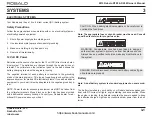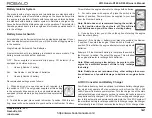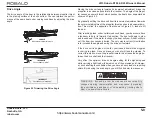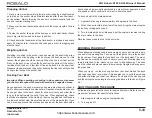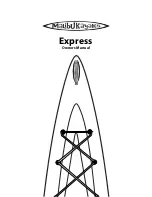
2013 Robalo R180 & R200 Owner’s Manual
Robalo Boats, LLC
Nashville, GA
robalo.com
5-3
Bunk or Custom Trailers—Loading
When loading, always prepare for the procedure prior to reaching the
ramp. If the ramp is busy, preparation will shorten the time it takes for you
to get your boat out of the water.
You probably won’t have to back the trailer into the water as far to load
the boat as you did to launch it. In fact, the easiest way is to back your
trailer up until the rear of the bunks is in the water. By not putting your
trailer too deep in the water, your boat will actually center itself on the
bunks about 1/3 to 1/2 the distance onto the trailer.
Connect the winch cable/strap to the bow eye of the boat. Lock your
winch before attempting to wind the cable/strap in. Once your boat is
aligned and is pulled
fi
rmly against the winch stand roller or vee block and
your winch is in the locked position, connect the boat bow safety chain
and you are ready to drive to the loading/preparation area near the ramp
to connect all other tie-downs, lighting or electric brake connections, etc.
Common Cause of Boat Misalignment
If your boat doesn’t sit level in the water or your bunks or rollers are not
adjusted properly, you may have misalignment problems with your boat
when loading. Basic correction procedures are as follows:
Correction Procedures:
Re-measure all roller assemblies that set in a line across from each other.
Make sure the distance to each roller from the centerline of the trailer is
equal. In other words, the left side of your trailer should be exactly the
same as the right side. This is true of bunk or roller trailers.
If your boat keeps going to the port (left) side, remove the boat and loosen
the U-bolts and/or the through bolts that clamp the roller assemblies on
the stern (back) section of the trailer. Force each assembly to the right as
if you were trying to turn the handlebars of a bicycle. Hold each assembly
in this turned position and retighten the U-bolts and/or through bolts.
This repositioning of the roller assemblies should correct the misalign-
ment of the boat on your trailer. If your boat goes toward the starboard
(right) side, reverse the procedure.
Another common reason for boats not centering themselves is putting the
trailer too deep in the water, which does not allow the trailer adequate time
to center the boat. This is especially true on roller style trailers. Please
Note: Make sure your trailer is not too deep in the water or the boat will
fl
oat over the rollers and be dif
fi
cult to load and center.
BOARDING YOUR BOAT
The U.S. Coast Guard requires that a capacity plate be af
fi
xed to all
boats up to 20 feet long. This plate states the maximum load capac-
ity. The plate shows persons and gear in pounds the boat will handle
safely under normal conditions. The U.S. Coast Guard establishes these
load capacity ratings. Overloading and improper distribution of weight are
signi
fi
cant causes of accidents. Keep weight below maximum limits for
safety in turbulent water.
Important: The presence of the capacity plate does not relieve the boat
operator from the responsibility of using common sense or sound judge-
ment. Turbulent waters and adverse weather conditions reduce the maxi-
mum load capacity rating of the boat.
When loading your gear on board your boat, remember to distribute the
load evenly, keep the load low and do not overload. Always step onto the
boat, never jump! Have someone on the dock pass your gear aboard.
Secure all gear
fi
rmly so that it will not move or interfere with operation
of the boat.
The way your passengers are seated and gear stowed in the boat affects
your boat’s performance. Passengers should board the boat one at a
time and
fi
nd a seat. Passengers should remain seated during loading
of gear to maintain an even trim. Distribute your passengers and gear so
that your boat is balanced side to side and front to rear (Figure 5.1).
https://www.boat-manuals.com/

